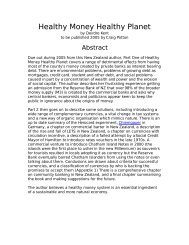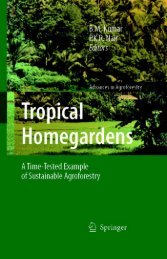Loren Nancarrow and Janet Hogan Taylor - library.uniteddiversity ...
Loren Nancarrow and Janet Hogan Taylor - library.uniteddiversity ...
Loren Nancarrow and Janet Hogan Taylor - library.uniteddiversity ...
Create successful ePaper yourself
Turn your PDF publications into a flip-book with our unique Google optimized e-Paper software.
1. When organic material is<br />
organisms to move in are the psychrophilic bacteria.<br />
These bacteria, which prefer temperatures below 70°F,<br />
start eating the fresh material. Over 70°F the mesophilic<br />
bacteria, which like to live in temperatures between 70<br />
<strong>and</strong> 113°F, start taking over. Unfortunately for the<br />
mesophilic bacteria, their feeding <strong>and</strong> respiration causes<br />
carbon dioxide (CO2) to be released <strong>and</strong> energy in the<br />
form of heat to warm up the pile. These conditions soon<br />
start killing the mesophilic bacteria.<br />
2. The next organisms, the thermophilic microorganisms<br />
that love temperatures of 113 to 170°F, now move in <strong>and</strong><br />
start consuming the organic matter <strong>and</strong> the dead<br />
mesophilic bacteria. This feeding continues until the food<br />
supply gets low, reducing the numbers of thermophilic<br />
microorganisms. The pile starts to cool down.<br />
3. When the pile cools enough (70 to 75°F is ideal), the<br />
actinomycetes <strong>and</strong> fungi are ready to take over <strong>and</strong> eat<br />
whatever is left, including the thermophilic microorganisms.<br />
The actinomycetes are higher forms of bacteria that<br />
contribute to the formation of humus. They also improve<br />
the soil by releasing various nutrients, such as nitrogen<br />
<strong>and</strong> carbon. Actinomycetes are the organisms you smell<br />
in finished, earthy compost. The fungi are there too, eating<br />
their part. Fungi are primitive plants that do not contain<br />
chlorophyll <strong>and</strong> cannot produce their own<br />
carbohydrates. They must get their energy from the<br />
organic material by breaking it down into its constituent<br />
building-block compounds.<br />
Now, if this was a simple compost pile, you could at this<br />
point add new organic matter <strong>and</strong> start the whole process again.<br />
However, in a vermicompost system, we add earthworms to our<br />
system <strong>and</strong> it changes the series of events a bit.<br />
First we will consider the events <strong>and</strong> organisms we have just<br />
mentioned as first-level consumers. They are the first ones at the<br />
dinner table, so to speak.<br />
26 The Worm Book














